HI6008 - Literature Review: Cloud Accounting & Australian SMEs
VerifiedAdded on 2023/04/10
|6
|1724
|199
Literature Review
AI Summary
This literature review examines the impact of automated cloud accounting on Small and Medium Size Enterprises (SMEs) in Australia. It discusses the shift from traditional accounting software to cloud-based systems, highlighting the benefits such as improved efficiency, cost savings, and enhanced accessibility. The review also addresses challenges like security concerns and the impact on accounting and auditing professions. It further explores the potential of big data analytics in cloud accounting and the diversification of cloud services available to SMEs, emphasizing the need for businesses to embrace cloud technology for future growth and sustainability. Desklib provides access to similar solved assignments and resources for students.
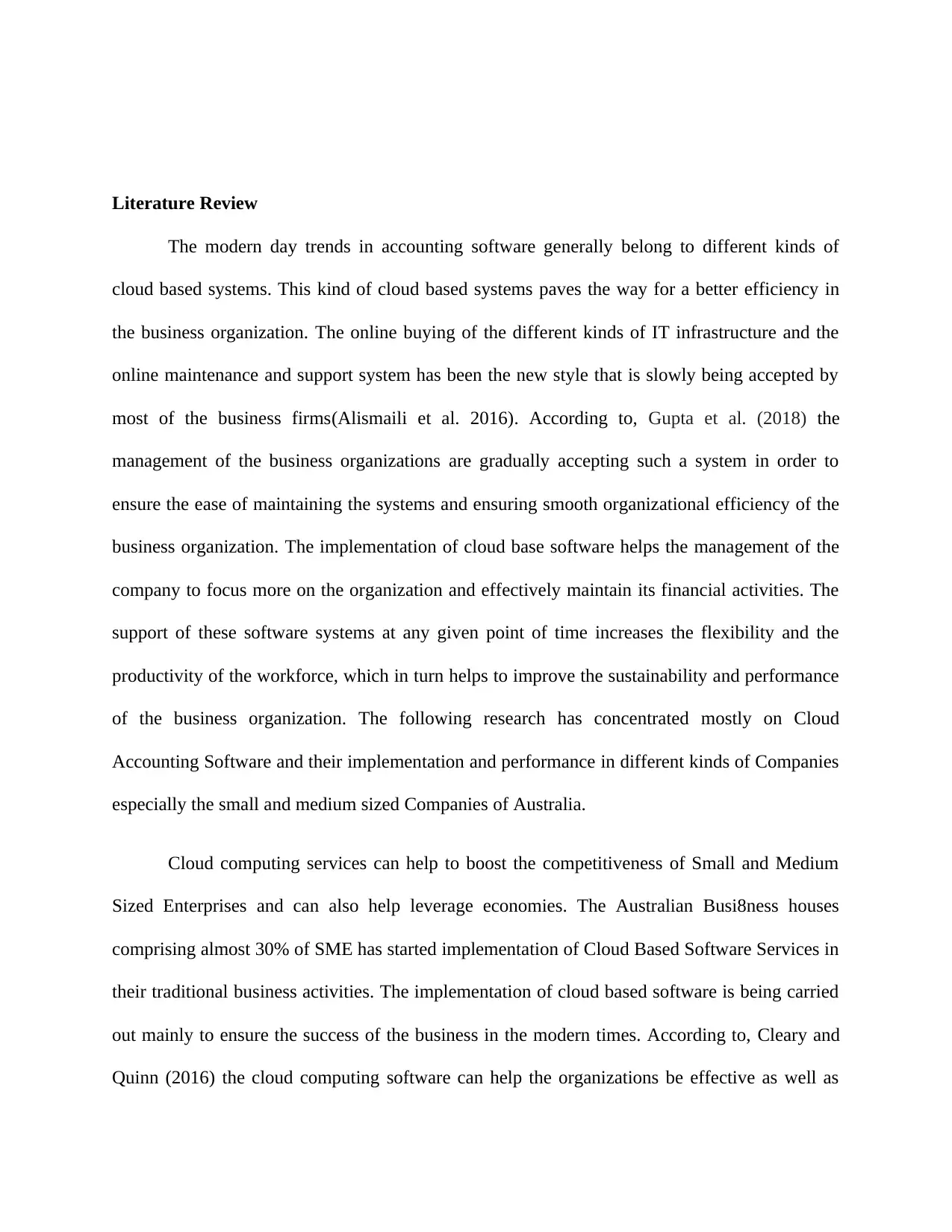
Literature Review
The modern day trends in accounting software generally belong to different kinds of
cloud based systems. This kind of cloud based systems paves the way for a better efficiency in
the business organization. The online buying of the different kinds of IT infrastructure and the
online maintenance and support system has been the new style that is slowly being accepted by
most of the business firms(Alismaili et al. 2016). According to, Gupta et al. (2018) the
management of the business organizations are gradually accepting such a system in order to
ensure the ease of maintaining the systems and ensuring smooth organizational efficiency of the
business organization. The implementation of cloud base software helps the management of the
company to focus more on the organization and effectively maintain its financial activities. The
support of these software systems at any given point of time increases the flexibility and the
productivity of the workforce, which in turn helps to improve the sustainability and performance
of the business organization. The following research has concentrated mostly on Cloud
Accounting Software and their implementation and performance in different kinds of Companies
especially the small and medium sized Companies of Australia.
Cloud computing services can help to boost the competitiveness of Small and Medium
Sized Enterprises and can also help leverage economies. The Australian Busi8ness houses
comprising almost 30% of SME has started implementation of Cloud Based Software Services in
their traditional business activities. The implementation of cloud based software is being carried
out mainly to ensure the success of the business in the modern times. According to, Cleary and
Quinn (2016) the cloud computing software can help the organizations be effective as well as
The modern day trends in accounting software generally belong to different kinds of
cloud based systems. This kind of cloud based systems paves the way for a better efficiency in
the business organization. The online buying of the different kinds of IT infrastructure and the
online maintenance and support system has been the new style that is slowly being accepted by
most of the business firms(Alismaili et al. 2016). According to, Gupta et al. (2018) the
management of the business organizations are gradually accepting such a system in order to
ensure the ease of maintaining the systems and ensuring smooth organizational efficiency of the
business organization. The implementation of cloud base software helps the management of the
company to focus more on the organization and effectively maintain its financial activities. The
support of these software systems at any given point of time increases the flexibility and the
productivity of the workforce, which in turn helps to improve the sustainability and performance
of the business organization. The following research has concentrated mostly on Cloud
Accounting Software and their implementation and performance in different kinds of Companies
especially the small and medium sized Companies of Australia.
Cloud computing services can help to boost the competitiveness of Small and Medium
Sized Enterprises and can also help leverage economies. The Australian Busi8ness houses
comprising almost 30% of SME has started implementation of Cloud Based Software Services in
their traditional business activities. The implementation of cloud based software is being carried
out mainly to ensure the success of the business in the modern times. According to, Cleary and
Quinn (2016) the cloud computing software can help the organizations be effective as well as
Paraphrase This Document
Need a fresh take? Get an instant paraphrase of this document with our AI Paraphraser
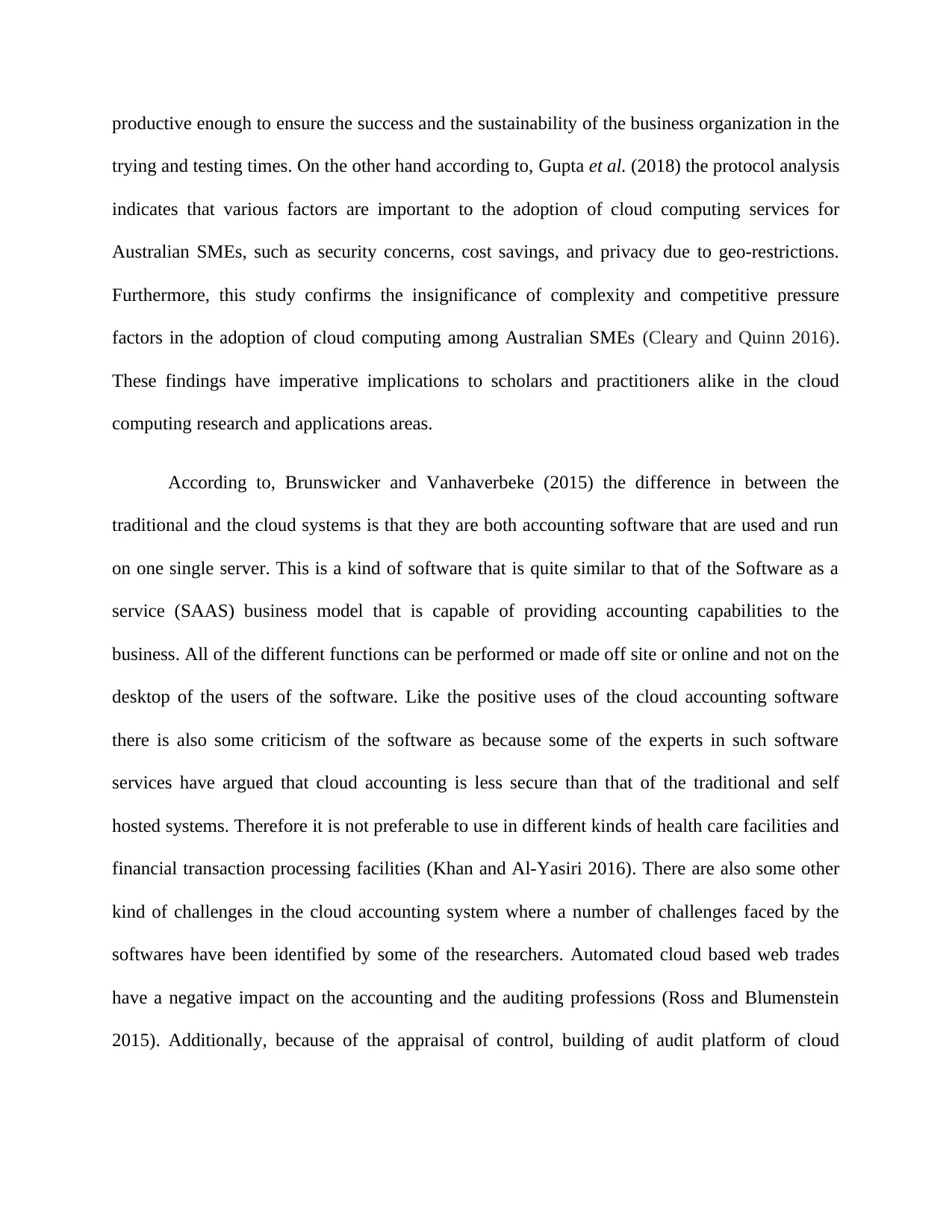
productive enough to ensure the success and the sustainability of the business organization in the
trying and testing times. On the other hand according to, Gupta et al. (2018) the protocol analysis
indicates that various factors are important to the adoption of cloud computing services for
Australian SMEs, such as security concerns, cost savings, and privacy due to geo-restrictions.
Furthermore, this study confirms the insignificance of complexity and competitive pressure
factors in the adoption of cloud computing among Australian SMEs (Cleary and Quinn 2016).
These findings have imperative implications to scholars and practitioners alike in the cloud
computing research and applications areas.
According to, Brunswicker and Vanhaverbeke (2015) the difference in between the
traditional and the cloud systems is that they are both accounting software that are used and run
on one single server. This is a kind of software that is quite similar to that of the Software as a
service (SAAS) business model that is capable of providing accounting capabilities to the
business. All of the different functions can be performed or made off site or online and not on the
desktop of the users of the software. Like the positive uses of the cloud accounting software
there is also some criticism of the software as because some of the experts in such software
services have argued that cloud accounting is less secure than that of the traditional and self
hosted systems. Therefore it is not preferable to use in different kinds of health care facilities and
financial transaction processing facilities (Khan and Al-Yasiri 2016). There are also some other
kind of challenges in the cloud accounting system where a number of challenges faced by the
softwares have been identified by some of the researchers. Automated cloud based web trades
have a negative impact on the accounting and the auditing professions (Ross and Blumenstein
2015). Additionally, because of the appraisal of control, building of audit platform of cloud
trying and testing times. On the other hand according to, Gupta et al. (2018) the protocol analysis
indicates that various factors are important to the adoption of cloud computing services for
Australian SMEs, such as security concerns, cost savings, and privacy due to geo-restrictions.
Furthermore, this study confirms the insignificance of complexity and competitive pressure
factors in the adoption of cloud computing among Australian SMEs (Cleary and Quinn 2016).
These findings have imperative implications to scholars and practitioners alike in the cloud
computing research and applications areas.
According to, Brunswicker and Vanhaverbeke (2015) the difference in between the
traditional and the cloud systems is that they are both accounting software that are used and run
on one single server. This is a kind of software that is quite similar to that of the Software as a
service (SAAS) business model that is capable of providing accounting capabilities to the
business. All of the different functions can be performed or made off site or online and not on the
desktop of the users of the software. Like the positive uses of the cloud accounting software
there is also some criticism of the software as because some of the experts in such software
services have argued that cloud accounting is less secure than that of the traditional and self
hosted systems. Therefore it is not preferable to use in different kinds of health care facilities and
financial transaction processing facilities (Khan and Al-Yasiri 2016). There are also some other
kind of challenges in the cloud accounting system where a number of challenges faced by the
softwares have been identified by some of the researchers. Automated cloud based web trades
have a negative impact on the accounting and the auditing professions (Ross and Blumenstein
2015). Additionally, because of the appraisal of control, building of audit platform of cloud
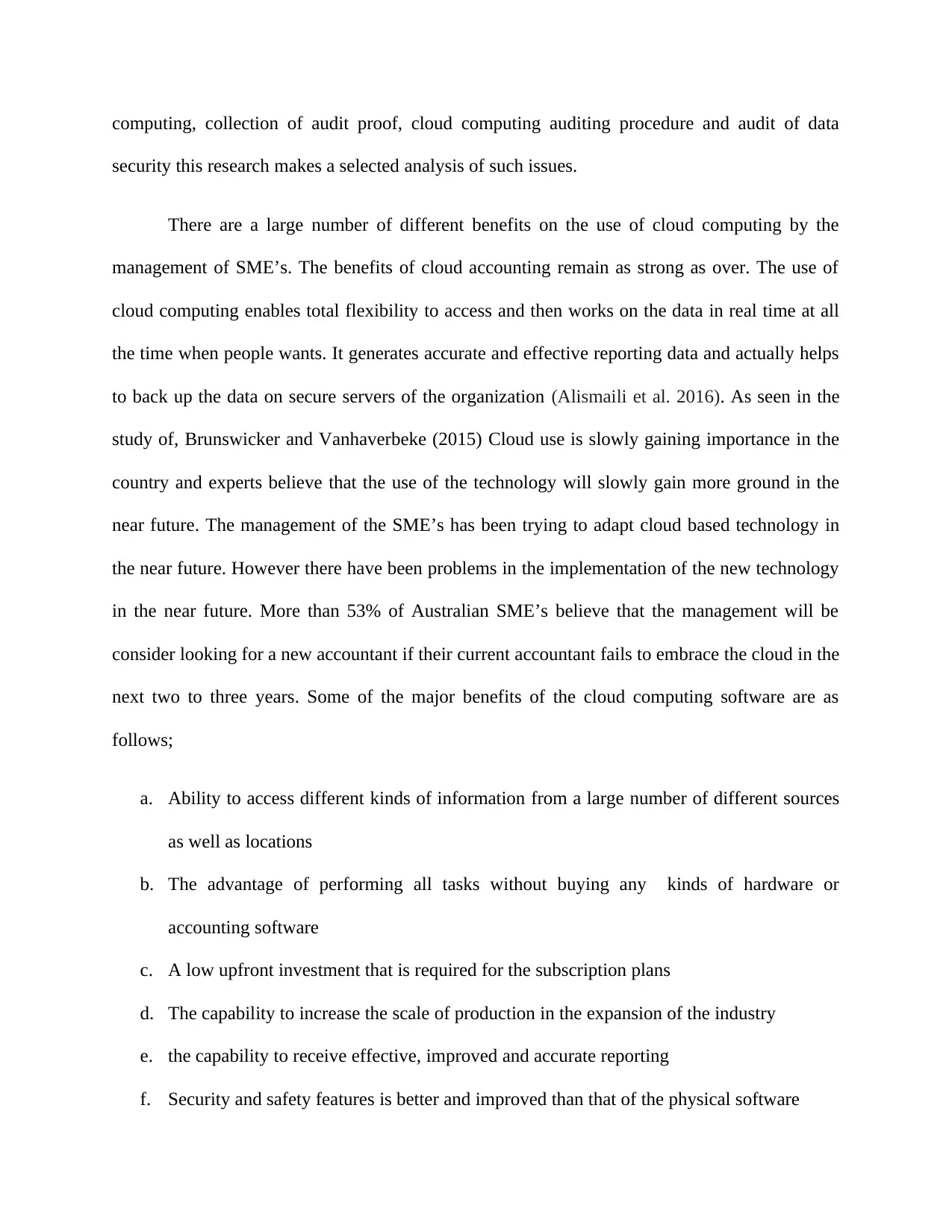
computing, collection of audit proof, cloud computing auditing procedure and audit of data
security this research makes a selected analysis of such issues.
There are a large number of different benefits on the use of cloud computing by the
management of SME’s. The benefits of cloud accounting remain as strong as over. The use of
cloud computing enables total flexibility to access and then works on the data in real time at all
the time when people wants. It generates accurate and effective reporting data and actually helps
to back up the data on secure servers of the organization (Alismaili et al. 2016). As seen in the
study of, Brunswicker and Vanhaverbeke (2015) Cloud use is slowly gaining importance in the
country and experts believe that the use of the technology will slowly gain more ground in the
near future. The management of the SME’s has been trying to adapt cloud based technology in
the near future. However there have been problems in the implementation of the new technology
in the near future. More than 53% of Australian SME’s believe that the management will be
consider looking for a new accountant if their current accountant fails to embrace the cloud in the
next two to three years. Some of the major benefits of the cloud computing software are as
follows;
a. Ability to access different kinds of information from a large number of different sources
as well as locations
b. The advantage of performing all tasks without buying any kinds of hardware or
accounting software
c. A low upfront investment that is required for the subscription plans
d. The capability to increase the scale of production in the expansion of the industry
e. the capability to receive effective, improved and accurate reporting
f. Security and safety features is better and improved than that of the physical software
security this research makes a selected analysis of such issues.
There are a large number of different benefits on the use of cloud computing by the
management of SME’s. The benefits of cloud accounting remain as strong as over. The use of
cloud computing enables total flexibility to access and then works on the data in real time at all
the time when people wants. It generates accurate and effective reporting data and actually helps
to back up the data on secure servers of the organization (Alismaili et al. 2016). As seen in the
study of, Brunswicker and Vanhaverbeke (2015) Cloud use is slowly gaining importance in the
country and experts believe that the use of the technology will slowly gain more ground in the
near future. The management of the SME’s has been trying to adapt cloud based technology in
the near future. However there have been problems in the implementation of the new technology
in the near future. More than 53% of Australian SME’s believe that the management will be
consider looking for a new accountant if their current accountant fails to embrace the cloud in the
next two to three years. Some of the major benefits of the cloud computing software are as
follows;
a. Ability to access different kinds of information from a large number of different sources
as well as locations
b. The advantage of performing all tasks without buying any kinds of hardware or
accounting software
c. A low upfront investment that is required for the subscription plans
d. The capability to increase the scale of production in the expansion of the industry
e. the capability to receive effective, improved and accurate reporting
f. Security and safety features is better and improved than that of the physical software
⊘ This is a preview!⊘
Do you want full access?
Subscribe today to unlock all pages.

Trusted by 1+ million students worldwide
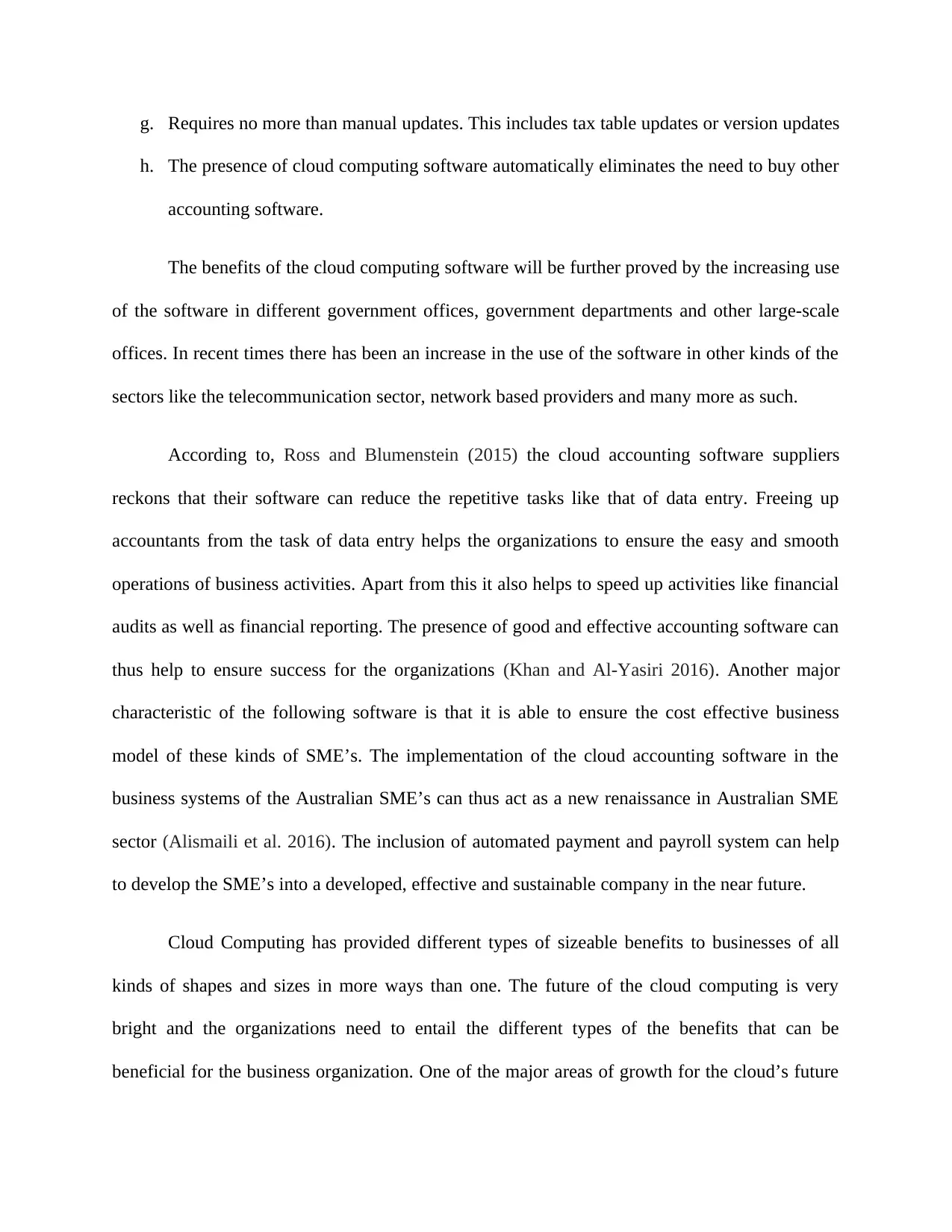
g. Requires no more than manual updates. This includes tax table updates or version updates
h. The presence of cloud computing software automatically eliminates the need to buy other
accounting software.
The benefits of the cloud computing software will be further proved by the increasing use
of the software in different government offices, government departments and other large-scale
offices. In recent times there has been an increase in the use of the software in other kinds of the
sectors like the telecommunication sector, network based providers and many more as such.
According to, Ross and Blumenstein (2015) the cloud accounting software suppliers
reckons that their software can reduce the repetitive tasks like that of data entry. Freeing up
accountants from the task of data entry helps the organizations to ensure the easy and smooth
operations of business activities. Apart from this it also helps to speed up activities like financial
audits as well as financial reporting. The presence of good and effective accounting software can
thus help to ensure success for the organizations (Khan and Al-Yasiri 2016). Another major
characteristic of the following software is that it is able to ensure the cost effective business
model of these kinds of SME’s. The implementation of the cloud accounting software in the
business systems of the Australian SME’s can thus act as a new renaissance in Australian SME
sector (Alismaili et al. 2016). The inclusion of automated payment and payroll system can help
to develop the SME’s into a developed, effective and sustainable company in the near future.
Cloud Computing has provided different types of sizeable benefits to businesses of all
kinds of shapes and sizes in more ways than one. The future of the cloud computing is very
bright and the organizations need to entail the different types of the benefits that can be
beneficial for the business organization. One of the major areas of growth for the cloud’s future
h. The presence of cloud computing software automatically eliminates the need to buy other
accounting software.
The benefits of the cloud computing software will be further proved by the increasing use
of the software in different government offices, government departments and other large-scale
offices. In recent times there has been an increase in the use of the software in other kinds of the
sectors like the telecommunication sector, network based providers and many more as such.
According to, Ross and Blumenstein (2015) the cloud accounting software suppliers
reckons that their software can reduce the repetitive tasks like that of data entry. Freeing up
accountants from the task of data entry helps the organizations to ensure the easy and smooth
operations of business activities. Apart from this it also helps to speed up activities like financial
audits as well as financial reporting. The presence of good and effective accounting software can
thus help to ensure success for the organizations (Khan and Al-Yasiri 2016). Another major
characteristic of the following software is that it is able to ensure the cost effective business
model of these kinds of SME’s. The implementation of the cloud accounting software in the
business systems of the Australian SME’s can thus act as a new renaissance in Australian SME
sector (Alismaili et al. 2016). The inclusion of automated payment and payroll system can help
to develop the SME’s into a developed, effective and sustainable company in the near future.
Cloud Computing has provided different types of sizeable benefits to businesses of all
kinds of shapes and sizes in more ways than one. The future of the cloud computing is very
bright and the organizations need to entail the different types of the benefits that can be
beneficial for the business organization. One of the major areas of growth for the cloud’s future
Paraphrase This Document
Need a fresh take? Get an instant paraphrase of this document with our AI Paraphraser
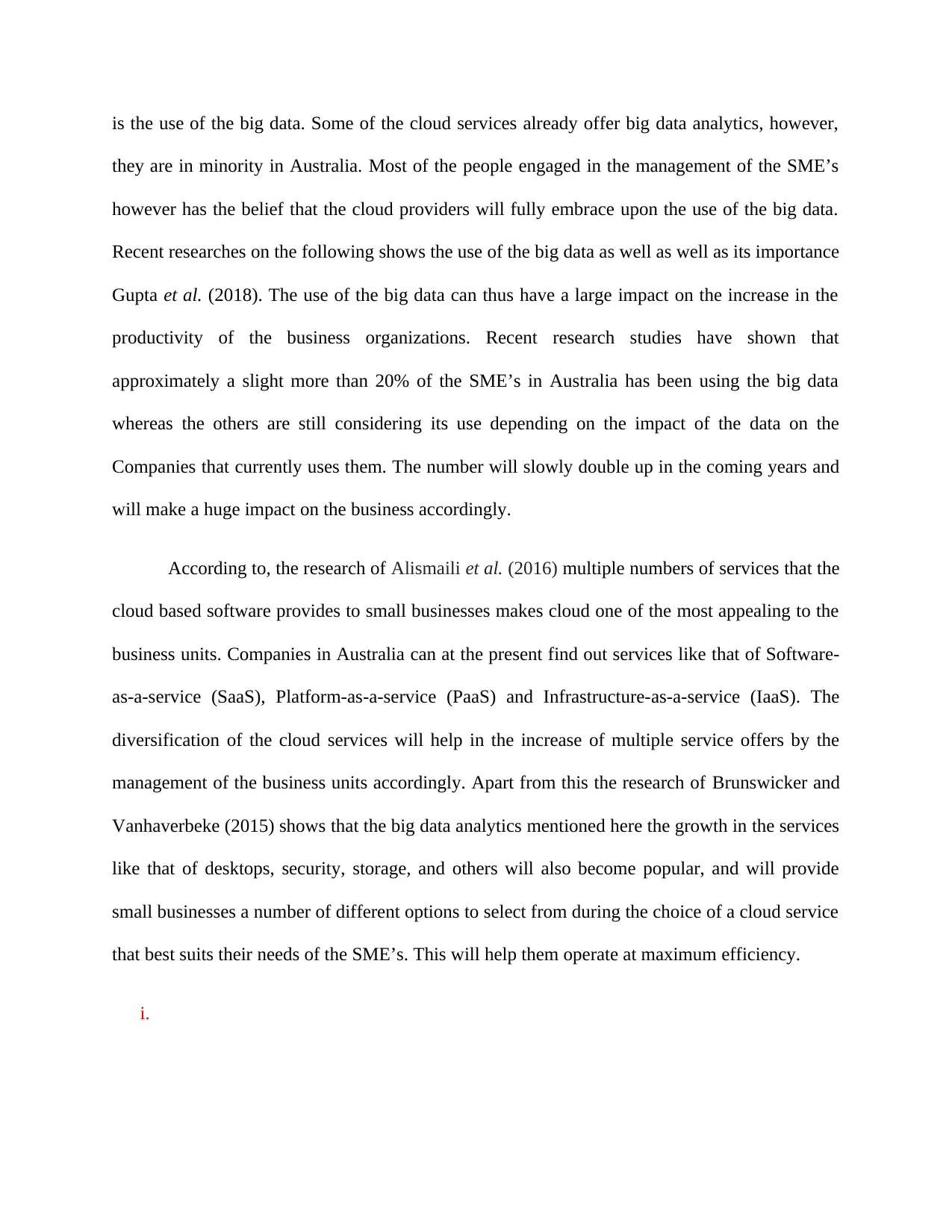
is the use of the big data. Some of the cloud services already offer big data analytics, however,
they are in minority in Australia. Most of the people engaged in the management of the SME’s
however has the belief that the cloud providers will fully embrace upon the use of the big data.
Recent researches on the following shows the use of the big data as well as well as its importance
Gupta et al. (2018). The use of the big data can thus have a large impact on the increase in the
productivity of the business organizations. Recent research studies have shown that
approximately a slight more than 20% of the SME’s in Australia has been using the big data
whereas the others are still considering its use depending on the impact of the data on the
Companies that currently uses them. The number will slowly double up in the coming years and
will make a huge impact on the business accordingly.
According to, the research of Alismaili et al. (2016) multiple numbers of services that the
cloud based software provides to small businesses makes cloud one of the most appealing to the
business units. Companies in Australia can at the present find out services like that of Software-
as-a-service (SaaS), Platform-as-a-service (PaaS) and Infrastructure-as-a-service (IaaS). The
diversification of the cloud services will help in the increase of multiple service offers by the
management of the business units accordingly. Apart from this the research of Brunswicker and
Vanhaverbeke (2015) shows that the big data analytics mentioned here the growth in the services
like that of desktops, security, storage, and others will also become popular, and will provide
small businesses a number of different options to select from during the choice of a cloud service
that best suits their needs of the SME’s. This will help them operate at maximum efficiency.
i.
they are in minority in Australia. Most of the people engaged in the management of the SME’s
however has the belief that the cloud providers will fully embrace upon the use of the big data.
Recent researches on the following shows the use of the big data as well as well as its importance
Gupta et al. (2018). The use of the big data can thus have a large impact on the increase in the
productivity of the business organizations. Recent research studies have shown that
approximately a slight more than 20% of the SME’s in Australia has been using the big data
whereas the others are still considering its use depending on the impact of the data on the
Companies that currently uses them. The number will slowly double up in the coming years and
will make a huge impact on the business accordingly.
According to, the research of Alismaili et al. (2016) multiple numbers of services that the
cloud based software provides to small businesses makes cloud one of the most appealing to the
business units. Companies in Australia can at the present find out services like that of Software-
as-a-service (SaaS), Platform-as-a-service (PaaS) and Infrastructure-as-a-service (IaaS). The
diversification of the cloud services will help in the increase of multiple service offers by the
management of the business units accordingly. Apart from this the research of Brunswicker and
Vanhaverbeke (2015) shows that the big data analytics mentioned here the growth in the services
like that of desktops, security, storage, and others will also become popular, and will provide
small businesses a number of different options to select from during the choice of a cloud service
that best suits their needs of the SME’s. This will help them operate at maximum efficiency.
i.
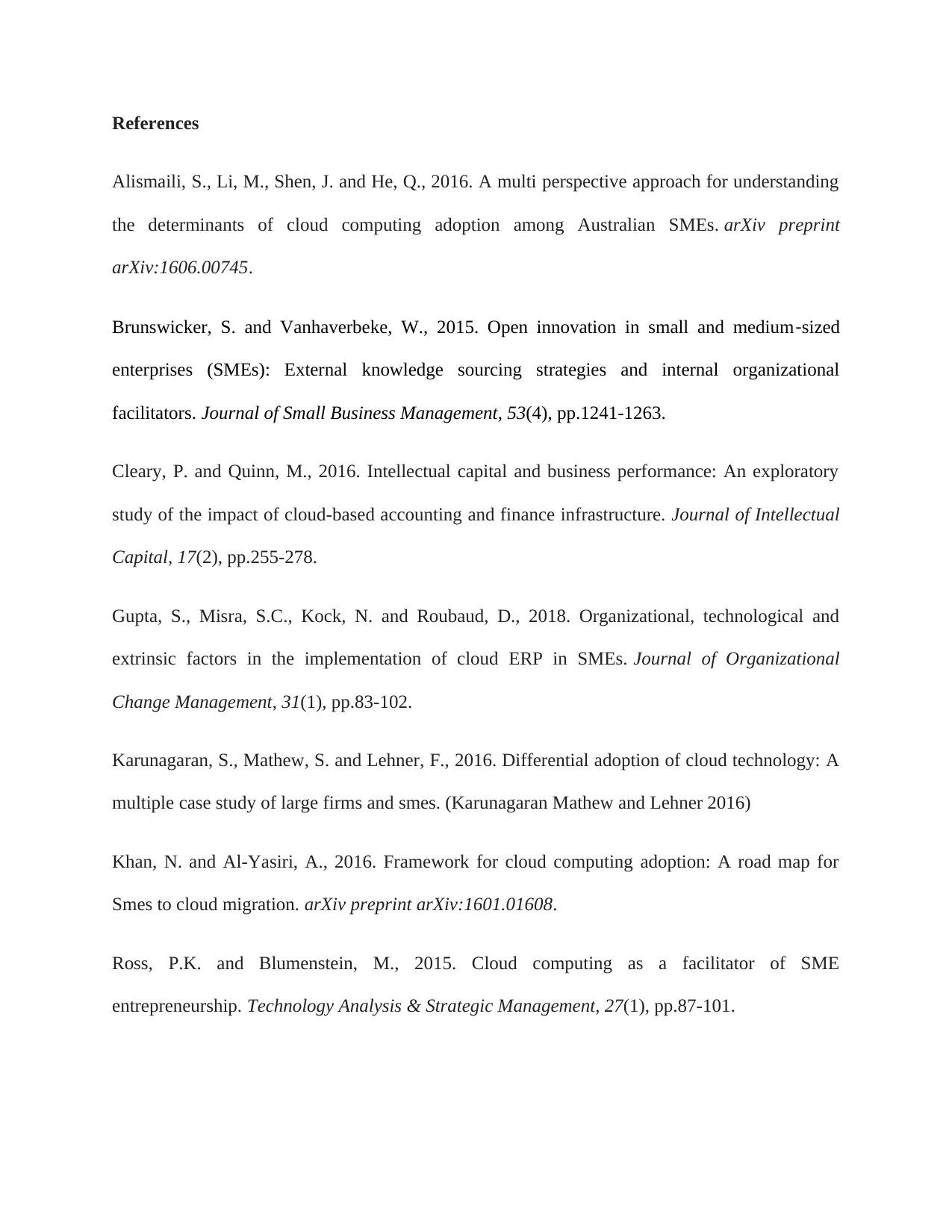
References
Alismaili, S., Li, M., Shen, J. and He, Q., 2016. A multi perspective approach for understanding
the determinants of cloud computing adoption among Australian SMEs. arXiv preprint
arXiv:1606.00745.
Brunswicker, S. and Vanhaverbeke, W., 2015. Open innovation in small and medium‐sized
enterprises (SMEs): External knowledge sourcing strategies and internal organizational
facilitators. Journal of Small Business Management, 53(4), pp.1241-1263.
Cleary, P. and Quinn, M., 2016. Intellectual capital and business performance: An exploratory
study of the impact of cloud-based accounting and finance infrastructure. Journal of Intellectual
Capital, 17(2), pp.255-278.
Gupta, S., Misra, S.C., Kock, N. and Roubaud, D., 2018. Organizational, technological and
extrinsic factors in the implementation of cloud ERP in SMEs. Journal of Organizational
Change Management, 31(1), pp.83-102.
Karunagaran, S., Mathew, S. and Lehner, F., 2016. Differential adoption of cloud technology: A
multiple case study of large firms and smes. (Karunagaran Mathew and Lehner 2016)
Khan, N. and Al-Yasiri, A., 2016. Framework for cloud computing adoption: A road map for
Smes to cloud migration. arXiv preprint arXiv:1601.01608.
Ross, P.K. and Blumenstein, M., 2015. Cloud computing as a facilitator of SME
entrepreneurship. Technology Analysis & Strategic Management, 27(1), pp.87-101.
Alismaili, S., Li, M., Shen, J. and He, Q., 2016. A multi perspective approach for understanding
the determinants of cloud computing adoption among Australian SMEs. arXiv preprint
arXiv:1606.00745.
Brunswicker, S. and Vanhaverbeke, W., 2015. Open innovation in small and medium‐sized
enterprises (SMEs): External knowledge sourcing strategies and internal organizational
facilitators. Journal of Small Business Management, 53(4), pp.1241-1263.
Cleary, P. and Quinn, M., 2016. Intellectual capital and business performance: An exploratory
study of the impact of cloud-based accounting and finance infrastructure. Journal of Intellectual
Capital, 17(2), pp.255-278.
Gupta, S., Misra, S.C., Kock, N. and Roubaud, D., 2018. Organizational, technological and
extrinsic factors in the implementation of cloud ERP in SMEs. Journal of Organizational
Change Management, 31(1), pp.83-102.
Karunagaran, S., Mathew, S. and Lehner, F., 2016. Differential adoption of cloud technology: A
multiple case study of large firms and smes. (Karunagaran Mathew and Lehner 2016)
Khan, N. and Al-Yasiri, A., 2016. Framework for cloud computing adoption: A road map for
Smes to cloud migration. arXiv preprint arXiv:1601.01608.
Ross, P.K. and Blumenstein, M., 2015. Cloud computing as a facilitator of SME
entrepreneurship. Technology Analysis & Strategic Management, 27(1), pp.87-101.
⊘ This is a preview!⊘
Do you want full access?
Subscribe today to unlock all pages.

Trusted by 1+ million students worldwide
1 out of 6
Related Documents
Your All-in-One AI-Powered Toolkit for Academic Success.
+13062052269
info@desklib.com
Available 24*7 on WhatsApp / Email
![[object Object]](/_next/static/media/star-bottom.7253800d.svg)
Unlock your academic potential
Copyright © 2020–2025 A2Z Services. All Rights Reserved. Developed and managed by ZUCOL.





